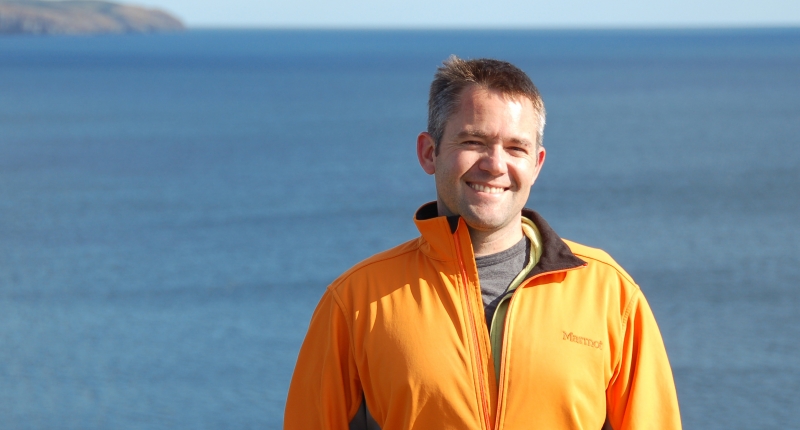NCEAS Portrait: Eric Ward Uses Economics to Analyze Ecosystems

Eric Ward epitomizes a synthesis scientist. By combining ecology, statistics, mathematical modeling, and even economics, he brings together multiple disciplines to study how ecosystems in the Northwestern U.S. respond to environmental change.
A quantitative ecologist at NOAA’s Northwestern Fisheries Science Center and an affiliate professor at the University of Washington’s School of Aquatic and Fisheries Science, Ward says working with graduate students helps him stay up to date on the latest statistical challenges and emerging problems in his field. Teaching has also motivated him to develop code and tools that are more useful to other scientists, helping to increase the transparency of his own research.
Ward also co-leads our Gulf of Alaska Portfolio Effects working group, and his novel methods are improving our understanding of the effects of environmental changes, namely the 1989 Exxon Valdez oil spill, on aquatic species and fisheries. The group utilizes portfolio theory, a economic model that explains how diversification of financial assets (or in this case, ecological biodiversity) minimizes risk. The team is wrapping up their research and has a few publications in the pipeline, making this an opportune time to feature Ward in this month’s Portrait.
How did you get into fisheries science?
EW: I took a bit of a circuitous path into fisheries. I did my undergrad mostly in ecology at UC San Diego. As a senior, I took a programming class and got really interested in using programming to solve problems. I then did my Masters at Montana State, but took a lot more statistics classes than ecology classes and realized that quantitative fisheries was a great fit for my interests.
Have you ever had an “aha” moment that has changed the way you think about your work?
EW: Over the next 20 to 30 years, I imagine I'll have a big "aha" moment, but that hasn't happened yet. I think one gradual change in my thinking, in part because of NCEAS, is a greater focus on how important the human dimension of our work is – both how humans change ecosystems and how human resource use changes in response to ecosystem change (e.g. fishing).
You use an economic approach called portfolio theory in your research. How effectively does a financial model translate to ecology?
EW: I think there are situations where portfolio theory does and doesn't translate to ecology. For managing multiple subpopulations of the same species, for example, diversification between subpopulations can translate into increased population persistence. In the case of our recent NCEAS related work, looking at diversification strategies for individual fishers, it gets a bit more complicated. We might expect, under portfolio theory, for individuals with more diverse catches (more species) to have reduced exposure to risk. That's true to some extent – individuals who own multiple permits can buffer themselves against variability. But we also see that individuals can benefit from specializing in only one thing. For future work, we'd like to understand the mechanisms for this a little more, whether it's an effect of accumulated experience or due to another factor.
What do you value most about working with a synthesis approach?
EW: I think the synthesis approach is great because it brings in a lot of people who have diverse skills or viewpoints on problems. I think incorporating diverse viewpoints can be a bit of a challenge sometimes, but for the working groups I've been a part of, I think we've gotten better outcomes and research from it.
I also think it's interesting to look at ecosystem changes through the lens of different datasets. A lot of the species we work on have different reactions to perturbations and complex life histories that might mask our ability to see change. Looking at common patterns or drivers across them is extremely important for understanding how these perturbations may have short- or long-term effects.
What are some future projects you’re excited about?
EW: I'm actively involved in developing new models of spatial processes and how those evolve through time. I think that's a pretty hot topic in the field right now. I'm also just kicking off a couple projects related to better understanding the effects of [fish] hatcheries on ecosystems. Salmon are an important species on the west coast, for both marine mammals and fisheries. I think this gets back to the questions related to the importance of the human dimension.
What keeps you inspired outside of work?
EW: I think the number one thing is probably being outside and experiencing nature with my family. Despite living in the middle of Seattle, I'm always amazed at how quickly we can get away into the wilderness. Our son is almost five, and I really enjoy watching him learn about the environment.
###
Soham Mistry was a Science Communications Fellow in 2018.
NCEAS Portraits feature the people behind our work and impact.
